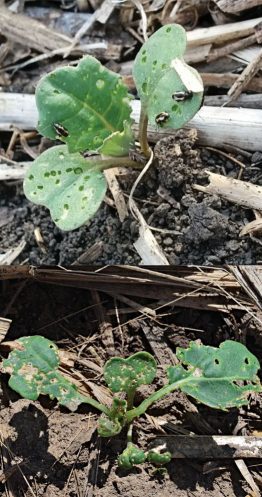Protect canola from early insect feeding
Key practice: Use seed treatments and early in-crop treatments, if scouting deems them necessary, to protect young plants from flea beetles.
Key research: Hallett, Rebecca, University of Guelph. “Assessing the Impact of Swede Midge on Canola Production in the Prairies & Ontario.” Canola Agronomic Research Program (CARP 2005-14).
Olfert, Owen and Elliott, Bob, Agriculture and Agri-Food Canada (AAFC). “Detection, Surveillance and Management of Weed, Insect and Disease Pests that Threaten the Economic Viability of Crop Production and the Environmental Health of Prairie Agro-Ecosystems.” Canola Digest Science Edition (2013).
Soroka, Julie, AAFC. “Mitigation of Risk to Canola from Spring Flea Beetle Injury.” Canola Digest Science Edition (2013).
Flea beetles and cutworms are the most common early-season insect pests of canola. Despite canola’s ability to branch out and recover from thinned stands, early insect feeding will reduce canola biomass and delay maturity, increasing the risk of lower yield and quality. The key to minimizing damage is early detection and the use of an insecticidal seed treatment to control flea beetles.
Rapid emergence and early growth is also very important to offset insect feeding, along with frequent scouting for feeding damage from germination through the early rosette stage. This will allow growers to intervene before significant plant losses occur.
Studies have shown annual canola yield losses from flea beetle damage ranging from eight to 10 percent, with insecticidal control being the principal management method. A three-year Canola-Flax Agri-Science Cluster study, led by Julie Soroka of AAFC Saskatoon, investigated flea beetles across the Prairies to determine factors affecting distribution and feeding and to analyze control methods.
Soroka found that striped flea beetles typically emerge first and are more active at temperatures lower than crucifer flea beetles. Crucifer flea beetles emerge at temperatures closer to 15°C and both species are more likely to fly from field to field when temperatures exceed 15°C.

Damage from both striped and crucifer flea beetles increased as the temperature increased. Crucifer flea beetle damage to cotyledons nearly doubled with each 5°C increase in temperature from 5°C to 25°C. Soroka advises growers to inspect canola daily when temperatures reach 20 to 25°C due to the rapid increase in damage at higher temperatures.
Researchers in this study found that current seed treatments provided substantially better control and protection against crucifer flea beetles than striped flea beetles. Also, seed treatments provided excellent flea beetle protection when warm, dry conditions occurred during germination and stand establish-ment. Seed treatments may be less effective when above-average rainfall causes saturated soil conditions or when striped flea beetles are the most abundant species.
Most flea beetle damage occurs at the cotyledon and early true leaf stages, with feeding after the fourth leaf stage having minimal impact on yield. An earlier seeding date takes advantage of the lower early spring temperatures during these growth stages and has proven to reduce injury.
Owen Olfert of AAFC conducted field tests over a three-year period to investigate the effect of seeding date on flea beetle damage, beetle emergence and agronomic performance of six canola and mustard cultivars, in the Canola-Flax Agri-Science Cluster study 3.7.8.
Olfert et al found that overall damage was lower in early seeded plots (14.6 percent) than in late seeded plots (21.4 percent). Seed yields were also
12 percent higher in early seeded plots than in late seeded plots, with early seeding improving overall yield by five to 20 percent depending on the cultivar.
Early seeding is also effective in mitigating damage from other insects, including cabbage seedpod weevil and swede midge. Swede midge is responsible for heavy losses in the Ontario canola growing region, and it was first found on the Prairies in Saskatchewan in 2007. This insect’s flexible biology could make it well adapted to the Prairies.
Rebecca Hallett of the University of Guelph has studied swede midge on canola in Ontario, and says canola must be planted early in areas of swede midge infestation. “By mid to late June, it may be best not to plant at all as damage will be very high, the crop will likely be unharvestable and resulting overwintering midge populations will present a risk to the following year’s crop,” says Hallett.




